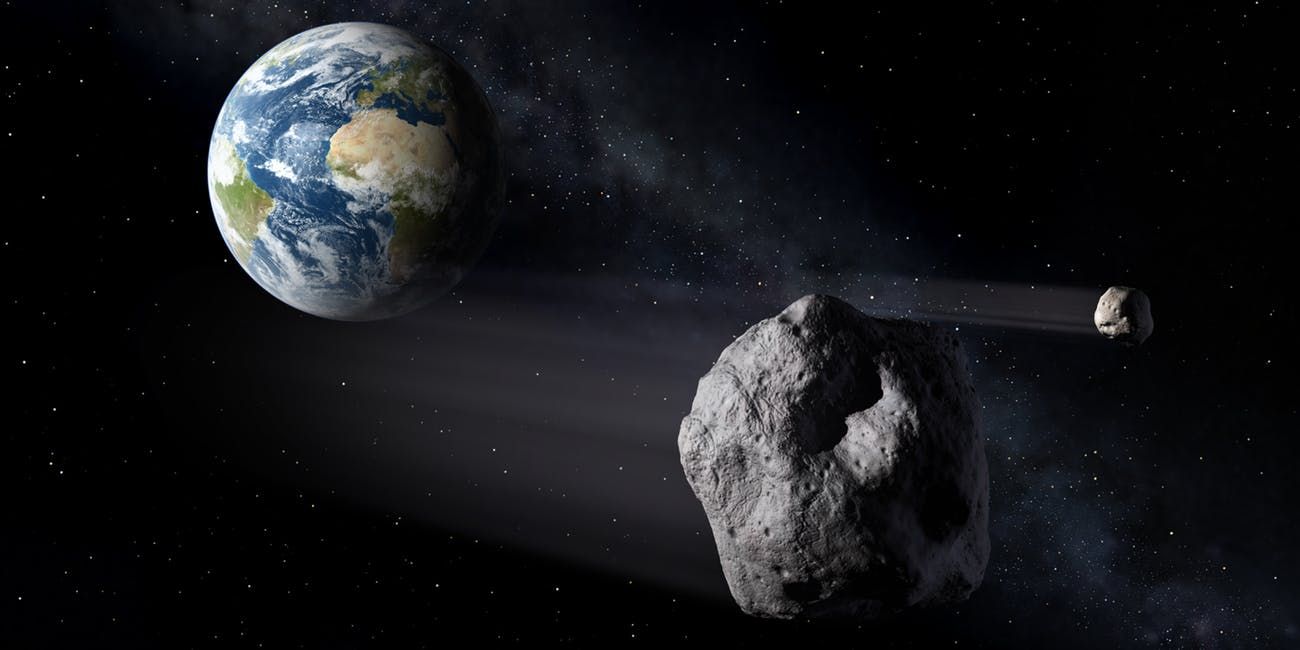Could Nearby Asteroids Be Hideouts for Alien Spies?
by Eric Mack March 26, 2019 (cnet.com)
• The vast majority of asteroids orbit the sun in a wide belt between Jupiter and Mars. Some wander farther into the inner solar system near Earth’s orbit. There’s a rarer type of object called a “quasi-satellite” that may spend centuries or longer making oddly shaped orbits around our planet. One example is asteroid 2016 HO3, also known as “Earth’s Constant Companion” (pictured above). These ‘co-orbital objects’ have only come to our attention in the past decade, for the most part. (watch 1:14 minute video on asteroid 2016 HO3 below)
• James Benford, a SETI enthusiast (the Search for Extraterrestrial Intelligence) has authored a paper that postulates that these “co-orbital objects [are] an attractive location for extraterrestrial intelligence to locate a probe to observe Earth while not being easily seen.” Benford refers to alien spies the sky as “lurkers.” We may not have noticed anything because any sort of ancient automated alien spy system could be dead or lie dormant for long periods of time.
• James Benford’s twin brother Gregory, an astrophysicist, also weighs in saying, “Lurkers from the far past may have done their duty and slowly failed … the ruins of Lurker installations, including mining for resources on nearby orbiting sites, may be visible, even though their animating intelligences are long gone.” “This means we should consider searches over decades-long time scales.”
• SETI focuses on looking beyond our solar system and essentially listening to distant stars for signs of life. James Benford argues that it’s much easier to prove or disprove some alien construction is in a near-Earth orbit. “We can observe them, ping them with radar, transmit messages to them, send robotic probes to them and visit them with human spacecraft missions,” writes Benford.
• Douglas Vakoch, formerly of the SETI Institute and currently president of METI (Messaging Extraterrestrial Intelligence), which is funded in part by NASA, says, “The notion of searching for lurkers by transmitting to likely locations in our solar system provides an intriguing possibility for finding common ground in Active SETI.” “Some of the same individuals who have been cautious about Active SETI transmissions to other stars are advocates of pinging nearby aliens — on the grounds that the extraterrestrials would already know we are here.”
• The idea that an extraterrestrial spy satellite might be hidden near our planet isn’t new. The late Stanford professor Ronald Bracewell proposed in a 1960 paper that advanced alien civilizations might place artificial intelligence near inhabited planets to monitor the progress of less advanced worlds and perhaps make contact at some point.
• “What have we to lose by checking out these objects?” Benford writes. “Nobody has really looked at these co-orbitals, other than orbital calculations and faint images. We know almost nothing about them.” Benford plans to submit his paper to the Astrophysical Journal.
Plans are in the works to send a tiny spacecraft to another star system in search of alien life. But what if another civilization has already launched a similar mission to observe Earth without our knowledge?
James Benford, who authored the definitive book on high-power microwaves and has written about the search for extraterrestrial intelligence, says in a draft paper that a “recently discovered group of nearby co-orbital objects is an attractive location for extraterrestrial intelligence (ETI) to locate a probe to observe Earth while not being easily seen.”

In the paper, which has yet to be peer-reviewed, Benford refers to alien eyes in (or above) the sky as “lurkers.” He goes on to give several examples of co-orbital objects (all of which are probably asteroids) that could be worth checking for them.
Benford runs a company called Microwave Sciences that designs and consults on high-power microwave systems. He often collaborates on his SETI (search for extraterrestrial intelligence) work with his twin brother Gregory Benford, a noted science-fiction author, and his son Dominic Benford, a scientist at NASA.
While the vast majority of asteroids orbit the sun in a wide belt between Jupiter and Mars, some wander farther into the inner solar system near Earth’s orbit.
There’s an even rarer type of object called a “quasi-satellite” that may spend centuries or longer making often oddly shaped orbits around our planet. One example is asteroid 2016 HO3, also known as “Earth’s Constant Companion,” which is detailed in the below video from NASA.
The idea that an extraterrestrial spy satellite might be hidden near our planet isn’t new. The late Stanford electrical engineering professor Ronald Bracewell proposed in an oft-referenced 1960 paper that advanced alien civilizations might place artificial intelligence near inhabited planets to monitor the progress of less advanced worlds and perhaps make contact at some point.
Of course, we have observatories keeping watch on the thousands of known near-Earth objects and discovering new ones almost daily. A handful of asteroids has been visited by spacecraft, including NASA’s Osiris-Rex and Japan’s Hayabusa-2 that are currently orbiting space rocks. So far, such observations have yielded no evidence of anything alien or artificial.
But the co-orbital objects that Benford said deserve more attention are relatively new discoveries, having come to our attention in the past decade for the most part. And we may not have noticed anything because any sort of automated alien spy system placed long ago could be dead or lie dormant for long periods of time, making it difficult to detect.
1:14 minute NASA video on Asteroid 2016 Ho3 – Earth’s Constant Companion
FAIR USE NOTICE: This page contains copyrighted material the use of which has not been specifically authorized by the copyright owner. ExoNews.org distributes this material for the purpose of news reporting, educational research, comment and criticism, constituting Fair Use under 17 U.S.C § 107. Please contact the Editor at ExoNews with any copyright issue.
